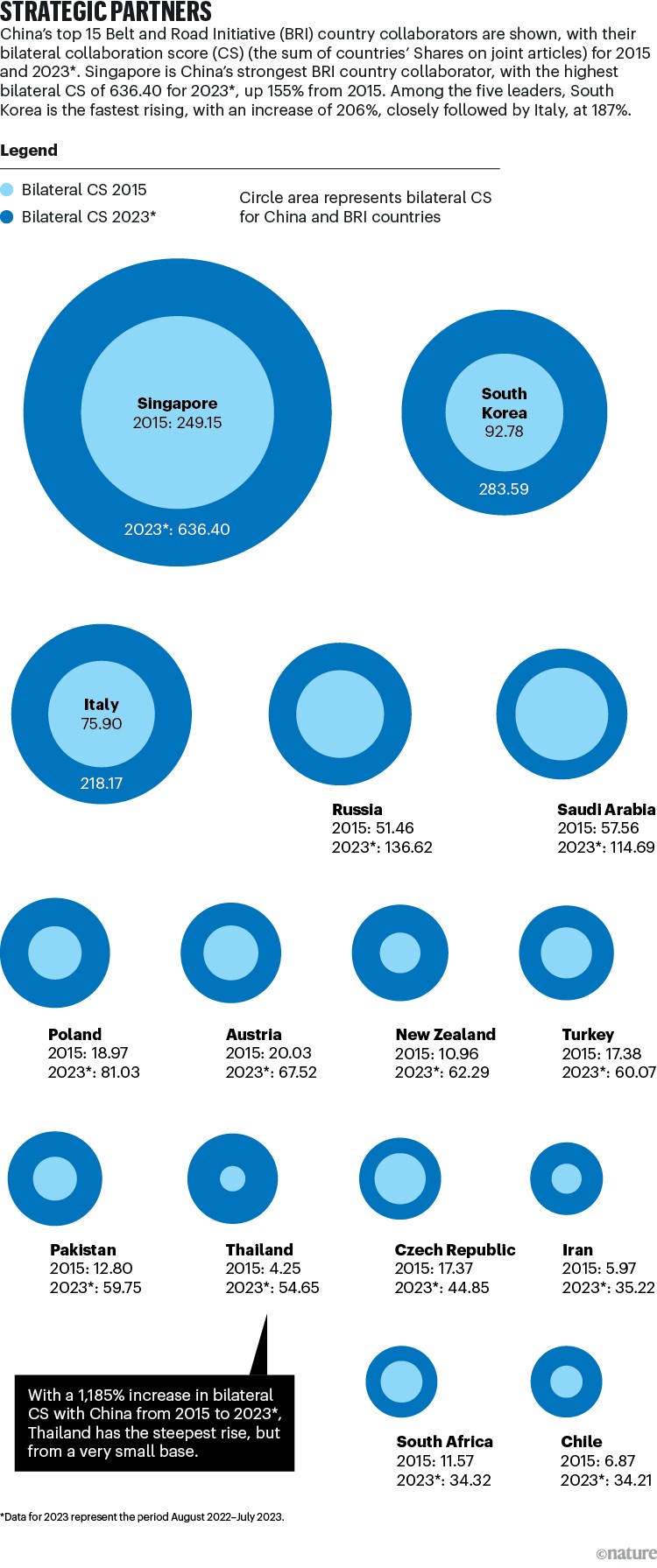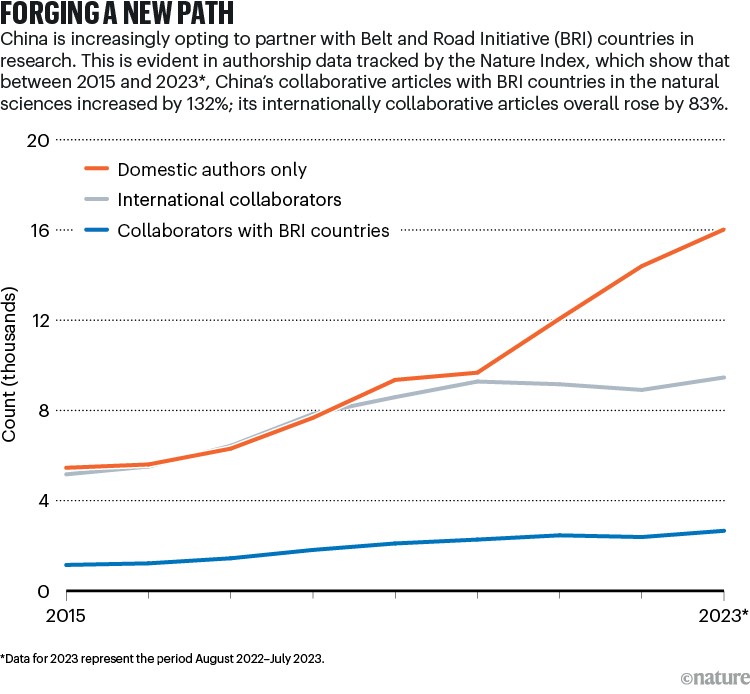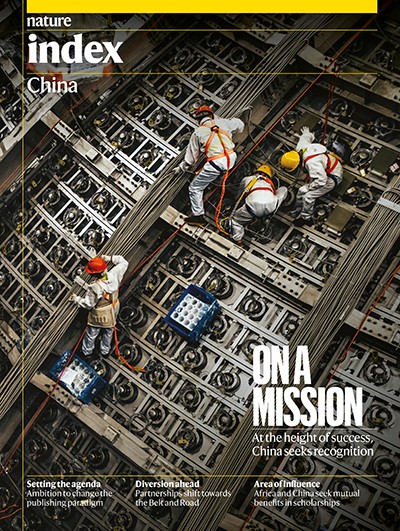Chinese research collaborations shift to the Belt and Road

Although China is expanding its international research collaborations rapidly, the composition of these interactions is shifting, according to data from the Nature Index. Specifically, China’s researchers are increasingly working with scientists in countries taking part in the Beijing government’s Belt and Road Initiative (BRI).
The BRI is often described as a modern-day reboot of the Silk Road, an ancient system of trade routes that connected China’s heartland with the eastern edge of Europe. Officially, the BRI is a bid to strengthen the resilience of China’s trade networks, both overland — across Asia into the Middle East and Africa — and by sea — upgrading ports and building maritime fuelling stations throughout the Asian continent.
Nature Index 2024 China
In reality it is about far more than just infrastructure. Sometimes referred to as Chinese President Xi Jinping’s signature policy, it’s an attempt to boost China’s economic and political influence by strengthening its ties with neighbours and other strategic partners around the world. The Green Finance and Development Center at Fudan University in Shanghai has been keeping track of the BRI’s progress. It estimates that China has spent more than US$1 trillion on the initiative since 2013 and that 151 countries have so far signed up to the project and the funding that comes with it.
In science, the BRI has spearheaded a range of initiatives, from Chinese researchers helping to design key pieces of infrastructure in Africa, to countries in central Asia working with China on lunar-exploration plans. Data trends in the Nature Index seem to reflect this. The number of natural-sciences research papers involving China and at least one BRI country has risen by 132% between 2015 and 2023 (data for 2023 are approximated by a 12-month window from August 2022 to July 2023). Such articles accounted for 28% of all of China’s international collaboration in the index in 2023, up from 22% in 2015. At the same time, the overall number of internationally collaborative papers involving China has increased at a slower rate — growing by 83% in the same time period. Collaborative research output with the United States in the natural sciences, measured by bilateral collaboration score (CS), decreased by 15% between 2020 and 2022 — and it has stagnated since then. The data suggest that researchers in China are starting to favour working with countries that are closer to home or deemed to be strategically important by the central government, over others, particularly in the West.

Source: Nature Index
“I’m not at all surprised,” says Caroline Wagner, a researcher at Ohio State University in Columbus who specializes in public policy that relates to science and innovation. “I did a study for the US state department, looking at all of the diplomatic agreements that China has made on science and tech with different countries, and we could see a tremendous rise [in BRI collaborations].”
Of the collaborations between China and BRI countries in the Nature Index, Singapore and South Korea come out on top. Singapore is China’s fifth largest research partner on papers in the database overall, including health sciences, with its bilateral CS rising by 8.4% between 2022 and 2023. These changes are likely to have been driven from the bottom up, says Jenny Lee, a science-policy researcher at the University of Arizona in Tucson. “It’s not like the Chinese Communist Party is saying to Chinese researchers that they must collaborate with these countries,” she says. Part of what the data are showing could also stem from China’s COVID-19 policy, which involved strict lockdowns and closed borders. “People didn’t go abroad to make connections at conferences during that time and it could just be that people in China are only just starting to do that again,” says Lee. Chinese scientists might still be wary of travelling farther afield to the United States and Europe, she says, and they might prefer to stay closer to home.
Part of the growth in China–BRI research collaborations could be explained by quirks in how academics identify themselves on research papers, says Robert Tijssen, a science and innovation studies researcher at Leiden University in the Netherlands. “A growing number of ‘cosmopolitan’ academic researchers have multiple institutional affiliations in different countries, especially countries that share a language or a common research culture. This may apply to China and Singapore,” he says. On papers, that could look like international collaboration when it’s more like Chinese researchers working with Chinese researchers.

Source: Nature Index
China’s domestic research collaborations are also skyrocketing: the number of natural-science papers in the Nature Index authored solely by China-based researchers grew by 194% between 2015 and 2023. The implication, says Lee, is that US hegemony as the ‘go-to place’ for researchers around the world is in peril. “It’s yet another demonstration of how global science is shifting away from the West. International collaboration will continue to grow,” she says, but it “may be shifting to a more regionalized model”.
Part of this is driven by geopolitics, she adds. Several countries, including the United Kingdom and United States, have banned Chinese firms such as Huawei from engaging in projects that involve key technology or infrastructure, such as telecommunications and electrical grids. The European Union is considering similar policies. That has a knock-on effect; researchers in China who are interested in working in these areas don’t change fields — they look for collaborators in other countries.
“You can’t collaborate with Chinese nationals if you have NASA funding” in the United States, says Lee. “When we look at sensitive areas of research, or anything to do with national security, the United States is closing access to data and resources. I suspect that this is probably where this trend away from the West is happening. These are areas and fields that are growing in Singapore and South Korea, so it makes sense.”
This article is part of Nature Index 2024 China, an editorially independent supplement. Advertisers have no influence over the content. For more information about Nature Index, see the homepage.









